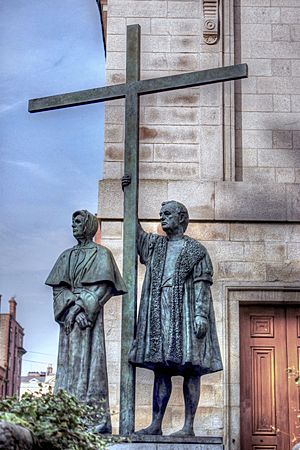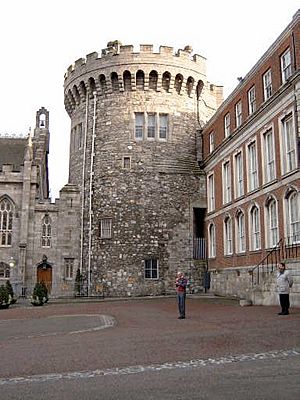Margaret Ball facts for kids
Quick facts for kids Blessed Margaret Ball |
|
|---|---|

A statue of the Blessed Margaret Ball
and of her grandson-in-law, the Blessed Francis Taylor, which stands in front of St. Mary's Pro-Cathedral, Dublin, Ireland |
|
| Born | 1515 Corballis, County Meath, Ireland |
| Died | 1584 (aged 68–69) Dublin Castle, Dublin, Ireland |
| Venerated in | Roman Catholic Church (Ireland) |
| Beatified | 27 September 1992, Vatican City by Pope John Paul II |
| Feast | 20 June |
Margaret Ball (1515–1584) was an important Irish woman in the 1500s. Even though she was the wife of a former Lord Mayor of Dublin, she was arrested for her strong Catholic faith. She died in the cold, dark dungeons of Dublin Castle. The Catholic Church later declared her a martyr, meaning someone who dies for their beliefs. She was made a "Blessed" (or beatified) in 1992, as one of 17 Irish Catholic Martyrs.
Contents
Margaret Ball's Early Life
Margaret was born Margaret Bermingham in a small area called Corballis. This place is now part of the village of Skryne in County Meath, Ireland. Her father, Nicholas, bought a farm there after moving from England. Her family later became involved in politics. Her brother, William Bermingham, spoke out in London against Earl Thomas Radclyffe. This was because Radclyffe was forcing the Protestant Reformation on Ireland for the young King Edward VI.
When Margaret was 16, she married Bartholomew Ball. He was an alderman, a kind of city council member, in Dublin. His family was rich and owned the bridge over the River Dodder, which is still known as Ballsbridge today. Margaret moved to Dublin and lived with Bartholomew at Ballygall House. They also had a house in the city on Merchant's Quay. They had ten children, but only five lived to be adults.
In 1553, Bartholomew Ball became the Lord Mayor of Dublin. This made Margaret the Lady Mayoress of the city. She had a comfortable life with many servants. She was also known for teaching classes to local children in her home.
Arrest and Imprisonment
In 1558, Queen Elizabeth I became queen. She changed the religious rules that her sister, Queen Mary, had put in place. Queen Elizabeth made her own Religious Settlement for all her lands. In 1570, the Holy See (the Pope) responded by saying Queen Elizabeth was not the rightful ruler. During this time, Catholics faced harsh treatment. Margaret Ball was known for offering "safe houses" to Catholic bishops and priests traveling through Dublin.
Margaret Ball's oldest son, Walter, wanted to become important in politics like his father. He chose to follow the "new religion" (Protestantism). In 1577, he was made a special officer for church matters. Margaret was very upset that her son changed his faith. She tried to convince him to change his mind.
One day, Margaret told Walter she had a "special friend" for him to meet. Walter arrived early with some soldiers. He found that the "special friend" was Dermot O'Hurley, the Archbishop of Cashel. The Archbishop was celebrating Mass with Margaret's family.

Soon after Walter became Lord Mayor of Dublin in 1580, he had his mother and her personal chaplain arrested. They were taken to the dungeons of Dublin Castle. Margaret was old and had severe arthritis, so she had to be carried to prison on a wooden board.
When her family protested, Walter said his mother should have been executed. But he had spared her life. He said she could go free if she "took the Oath." This probably meant the Oath of Supremacy, which would declare Queen Elizabeth as the head of the church.
Margaret's second son, Nicholas, supported his mother. He was elected Mayor of Dublin in 1582. However, Walter was still the special officer for church matters, a position given by the Queen. This meant Walter had more power than Nicholas. He stopped Nicholas from getting their mother released from prison. Nicholas visited her every day, bringing her food, clothes, and candles.
Margaret's Final Years
Margaret Ball died in 1584 at the age of sixty-nine. This was a very old age for that time. She had been crippled by arthritis and lived for three years in the cold, wet dungeon of Dublin Castle. There was no natural light in her cell. When she died, she was buried in the cemetery at St. Audoen's Church in Dublin. Even though she could have changed her will, she still left her property to Walter after her death.
Remembering Margaret Ball
Margaret Ball stayed in the dungeon even though she could have returned to her comfortable life at any time. All she had to do was "take the oath." Many years later, her grandson-in-law, Blessed Francis Taylor, also faced a similar choice. He was Mayor of Dublin from 1595 to 1596. He was put in prison after showing that there was cheating in the elections. He also refused to "take the oath" and died in Dublin Castle in 1621.
Margaret Ball and Francis Taylor never met. But they were both declared "Blessed" on the same day, September 27, 1992, by Pope John Paul II. This was done along with Dermot O'Hurley and 14 other Catholic martyrs.
Margaret Ball's Legacy
The Blessed Margaret Ball Chapel in Santry is named after her.
Margaret Ball, along with St. Columbanus and St. Mary MacKillop RSJ, was named a patron saint for a big Catholic event. This event was the 50th International Eucharistic Congress, held in Ireland in June 2012.
Her statue stands outside St. Mary's Pro-Cathedral in Dublin. She is one of only five historical women (not including Mary, mother of Jesus) to have a public statue in Dublin. The others are Catherine MacAuley (Baggot Street), Veronica Guerin (Dublin Castle), Constance Lloyd (Merrion Square), and Constance Markiewicz (who has three statues).


